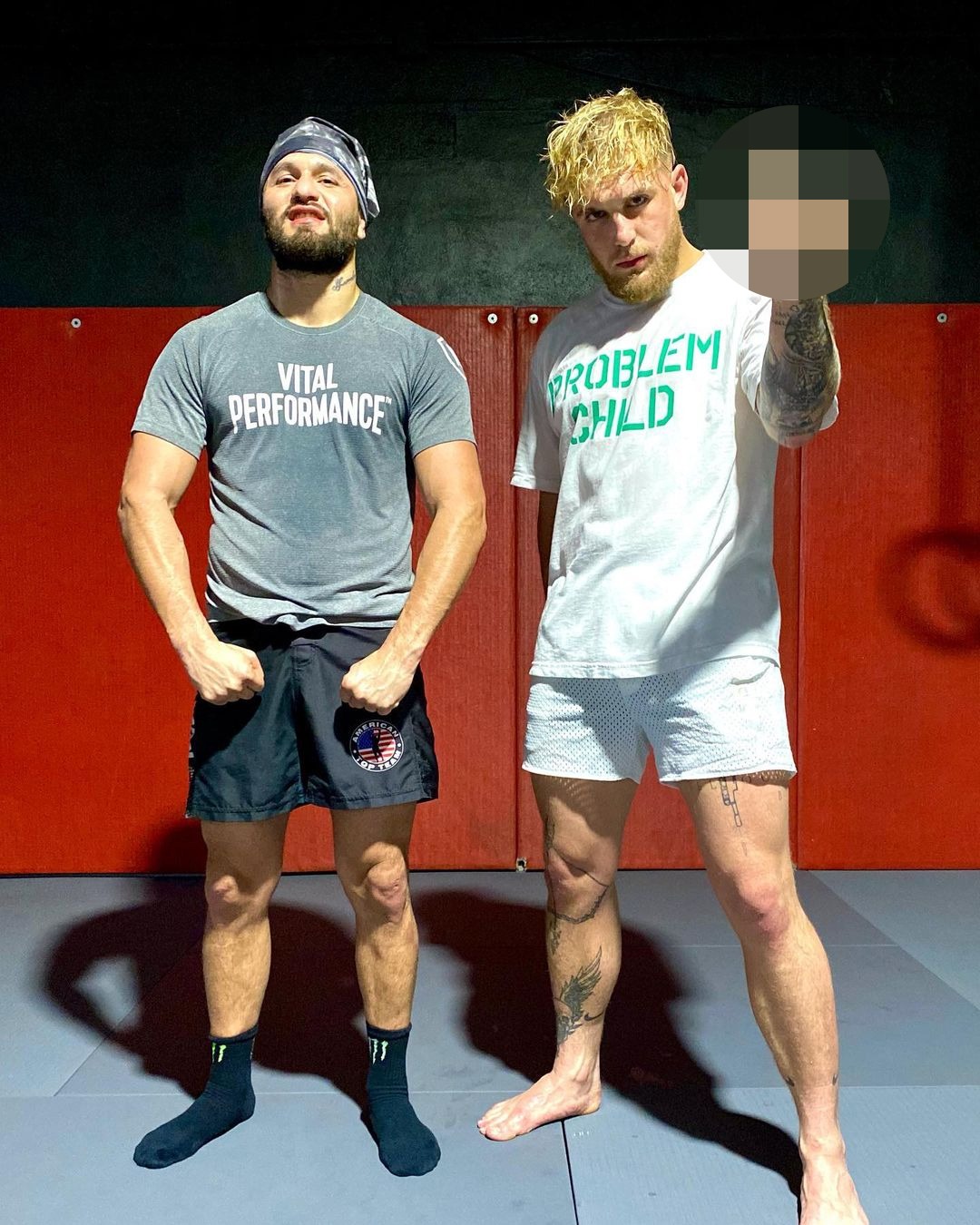JORGE MASVIDAL has accused Jake Paul of hypocrisy amid his row with UFC president Dana White over fighter pay.
Paul has campaigned against White to boost the minimum pay of UFC stars, revenue split and to add a healthcare system.
Jorge Masvidal with Dana White before his 2019 fight with Nate Diaz
Jake Paul has feuded with Dana White amid a row over UFC fighter pay
But current UFC welterweight Masvidal has defended White and accused the YouTuber-turned boxer of underpaying fighters on his cards.
Masvidal, 37, has just announced a boxing card promoted by himself and took a swipe at Paul, 26, in the process.
He said on The MMA Hour: “I put my money where my mouth is. This motherf***er Jake Paul be talking about he pays fighters.
“Shut the f*** up. When everybody sees what the f*** the card bill is, the whole card from top to bottom, I f***ing pay fighters.
“Me and my promotion pay fighters. My brothers and sisters so they can go earn a paycheck, kick ass and do what the f*** they do. All this other s*** is bulls*** and talk.”
Boxing legend Roy Jones Jr, 54, is set to headline a card promoted by Masvidal against ex-UFC champion Anthony Pettis, 36.
Meanwhile, Paul has headlined three events in his 6-0 career which have been co-promoted by his banner Most Valuable Promotions.
The American even paid all undercard fighters half of their purses when his August bout with Hasim Rahman Jr, 31, was cancelled.
But Masvidal has still accused Paul of only looking after himself as he defended his UFC boss White.
Masvidal said: “He’s always f***ing taking care of us and this doesn’t happen without Dana White and the UFC giving the permission so these guys can fight.
“When I hear somebody like Jake Paul talking s*** about my business partners, I’m like f*** this idiot, what the f*** have you done in this sport, but feed yourself?
“Shut the f*** up and now watch how the big boys do it.”

Jorge Masvidal pictured with Jake Paul
Frequently Asked Questions
How can a beginner get started in boxing?
Boxing is one the oldest known sports. Boxing was created in ancient times to help warriors fight off their enemies. Today, boxing is widely practiced all over the world. Boxing doesn’t require you to attend a gym. You only need a pair of gloves and some punching bags.
Local amateur boxing clubs are also available where you can train with professional coaches. After mastering basic punches, combinations, and other skills, you can compete in tournaments.
What is the difference in a left and right hook?
A left hook can be thrown from the side, and a right cross from the front.
A left hand hook is one that is thrown with the opponent’s right side facing. The elbow is bent 90 degrees and the wrist is turned 45 degrees toward the opponent.
A right cross is when the opponent’s palm faces the opponent and the elbow straightens. The opponent is 45 degrees from your wrist.
How can I improve my punching technique?
Boxing is all about good punch form. For you to become a better boxer, your punch technique must be perfected. These are some tips that will help you improve your punching technique.
- Keep your head high. When you are throwing punches, your head should be raised.
- Punch from the shoulder. When you throw a punch, try to hit the target from the shoulder instead of the chin.
- Keep your eyes on your feet. Focus on your feet when punching.
- Send short, sharp punches. You will feel tired quicker if you throw longer punches.
- Don’t forget about defense! Always remember to block incoming punches.
- Use your elbows. To defend yourself, your elbows are a good option.
- Your legs are your best friend. If you learn to use your legs properly, they can help you avoid getting knocked down.
- Do it every day. Even if you feel exhausted after training, don’t give up. It takes practice to become proficient at anything.
- Have fun Enjoy what your doing.
- Remember to breathe. Correct breathing will help you feel stronger and more energetic.
- Relax. Don’t worry about making errors. Don’t worry about making mistakes. Instead, focus on learning new skills.
- Be patient. Boxing takes practice. It takes time and practice to improve your skills.
- Never stop learning. As long there is still room for improvement, there will continue to be improvement.
- Listen to music. Listening to music can help you relax during training.
- Watch videos of professional boxers. It can inspire you to do better.
- Read books. Reading helps you to understand boxing techniques.
- Take breaks. Sometimes you might need to stop boxing. Play soccer or basketball outside.
- Find a coach. Coaching can make you more efficient at boxing.
- Push-ups are a great exercise. Push-ups can be a great way to increase strength and endurance.
What are the 7 punches in boxing?
The seven punches used in boxing include the jab (cross), hook, uppercut; straight right; left hook; and body shot. These punches can be used to strike the opponent’s head and body.
Statistics
- This article received 39 testimonials and 89% of readers who voted found it helpful, earning it our reader-approved status. (wikihow.com)
- You want to be running at roughly 75-80% of your top speed..5 mile slow, easy recovery jog at the end.[6]X Research source 2Mix in long runs, shadow boxing, and short sprints on non-interval days. (wikihow.com)
External Links
en.wikipedia.org
expertboxing.com
How To
These are the basics of boxing
How to box effectively
Boxing is one of the most popular sports in the world. It involves two people who attempt to knock each other out of their heads. The rules of boxing vary from country to country. In general, there are three types of boxing; Amateur, Professional and Olympic boxing.
Amateur boxing is often practiced at school, college, or university. This type of boxing includes sparring sessions with padded gloves and without any protection. Amateur boxing competitions usually last three rounds and last five minutes each. There are many styles of amateur boxing such as Kickboxing or Muay Thai, Taekwondo and Karate, Judo and Wrestling, among others.
Boxing professionals are usually trained in clubs, gyms, or stadiums. They use protective equipment, such as mouthpieces, nose guards, shin protectors, elbow pads knee pads, waist belts and groin protectors. Professional boxing contests last six rounds and last for four minutes each. There are many styles of professional boxing: Boxing, MMA (Mixed Martial Arts), Kickboxing and Muay Thai.
Olympic boxing takes place at the Olympics. Special protective gear must be worn by boxers to ensure compliance with international standards. The eight rounds last three minutes each and are held over eight rounds. Olympic boxing can be divided into two types: Light Flyweight (Heavyweight) and Heavyweight (Light Flyweight).
The basic skills of boxing are:
- Punching techniques
- Techniques for protecting yourself
- Footwork
- Stance
- Movement of the body
- Defense
- Combination
- Rotation
- Spare parts
Punching Techniques
There are seven types. Each punch is unique. Some punches are more powerful than others. An uppercut, for instance, requires tremendous strength. A straight punch on the other side requires less power, but is more effective than other punches.
There are many combinations that can be used to punch. These are combinations of punches which work together to achieve a goal. A combination can contain multiple parts. An example of this is a left hook, followed by a right crossing. This will damage the opponent’s jaw.
Guard Techniques
Boxers use their bodies to defend themselves against attack. He does so by using his arms, elbows and hands as well as his knees, knees and legs.
Legs
Boxers must use their legs to defend themselves against kicks. When he receives a kick, he raises his leg and moves away from the attacker. To avoid being kicked on his side, he will bend his knees if the attack is from the front. He will block the kick with his foot if the attack is coming from behind.
Elbows
Elbow strikes are very powerful because they inflict great pain. You can deliver an elbow strike directly or indirectly. Directly means that your opponent is hit with your forearm. However, indirectly means that your elbow strike is delivered with another part or your arm.
Hands
Boxers use their hands as a shield against incoming punches. Boxers use their hands to stop incoming punches. They raise their fists up above their heads and move towards the attack. They then touch the attackers fist.
Knees
When receiving a blow to the stomach, abdomen or chest, a boxer should bend his knees to absorb the impact. Knee strikes can be used to defend yourself.
Feet
When attacked, a boxer should step back and deliver counter-attacks. This will help him gain distance from his opponent. A boxer must also maintain his balance when responding to an opponent’s counter-attack.
Stances
To box effectively, a boxer must establish a stance. The way he defends him will be dictated by his stance. It is how he positions himself and where he faces the opponent. Boxers have many stances to choose from. Here are some of the most common ones:
- Low stance
- High stance
- Southpaw stance
- Western stance
Body Movement
Boxers must maneuver around their opponent to win fights. This requires changing your position, speed, and rhythm.
Rotation
Boxers rotate their arms when they throw a punch. Different types of punches require different speeds for the rotation.
Combinations
Timing of each punch is crucial to the effectiveness of a combination. A combination of strong and weak punches will produce a good result.
Spare parts
Sparring is a training session that improves boxing skills. Sparring allows a boxer to improve his mental and physical skills. The goal of sparring is to learn to fight, and not to get hurt.
To sum it all, boxing requires patience and dedication. To become a better fighter, you have to train hard and continue to work.

